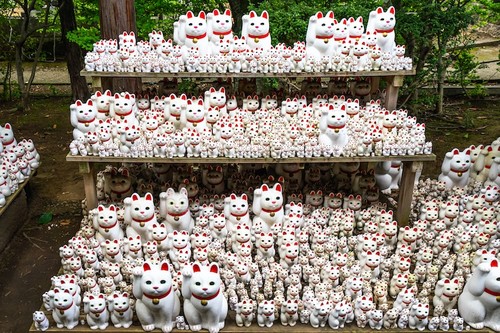 Thousands ofmaneki-neko statues displayed in the garden of Gotoku-ji Temple in Tokyo, Japan. (Stock photo from Francesco Bonico/Shutterstock) Thousands ofmaneki-neko statues displayed in the garden of Gotoku-ji Temple in Tokyo, Japan. (Stock photo from Francesco Bonico/Shutterstock) |
If you’ve ever been to Japan or any other part of Asia, you’ve probably seen a small ornamental cat waving at you in stores and restaurants.
According to Japanese people, that cat, named Maneki-Neko, symbolizes happiness and good fortune.
Usually made from ceramic, porcelain, or plastic, the bobtail cat has one paw raised in a beckoning gesture. The paw moves back and forth in a swinging motion, and sometimes is motorized so it can wave all day long. So how did Maneki-Neko get so famous?
As a woman at the Yamato Shrine explained, “Because it makes a beckoning gesture like this…Maneki-Neko brings happiness and good fortune to its owner by enticing customers to come inside.”
Also known as the welcoming cat, the lucky cat, the money cat, the happy cat, or the beckoning cat, today Maneki-Neko is recognizable all over the world.
Maneki-Neko originated in Gotokuji, a tranquil ancient temple nestled in the woods outside noisy Tokyo, where hundreds of Maneki-Neko of all sizes are displayed on wooden shelves.
Tesai Kagushawa, the temple’s chief monk, said, “Actually, the Maneki-Neko cats at Gotokuji Temple have all been donated by tourists. There is a rule about this. They bring them to the temple to thank them for bringing a whole year of happiness and good fortune. That's why we have so many Maneki-Neko cats here."
There are different versions of the legend of how the lucky cat was created. One is that in the early 17th century, Ii Naotaka, the second lord of the Omi-Hikone Domain, was caught in a sudden thunderstorm but was invited to take shelter inside the temple by a cat that lived there. To show his gratitude to the cat, Naotaka dedicated the temple to the Ii clan.
After Naotaka died, the temple was renamed Gotokuji, from Naotaka’s posthumous Buddhist name “Kyushoin-den Gotokuten ei-daikoji.”
The cat that created the opportunity for the temple to become a respected and important place was deified as the “Fortune-Inviting Kannon.” The cat was later called “Maneki-Neko” and Gotokuji temple has been filled with lucky cat figurines donated by worshippers ever since.
Another version of the figurine’s origin is that in the 17th century, a poor monk lived in Gotokuji temple with his pet cat. A samurai lord who was traveling through the region took shelter from a sudden storm under a large tree near the temple. He saw a cat waving to him with its paw from inside the temple.
Curious, he went closer to investigate the strange cat, when suddenly the tree behind him was completely destroyed by a bolt of lightning. Grateful to the cat for saving his life, the lord became the temple’s patron and rebuilt the crumbling structure to honor the lucky feline.
Today visitors to the temple bring representations of this cat as an offering to Buddha, as this is believed to make wishes come true and bring good fortune to those who donate a Maneki-Neko.
In Western culture, the beckoning gesture is made with your index finger with the palm of your hand facing your body.
In Japan, the beckoning gesture is made with all four fingers with your palm facing down. That’s why Maneki-Neko’s hand faces down. The raised arm can be either the left or right.
Becky Yarita of a doll shop said, “If you like Maneki Neko, it’s the right place to come. There are several types. They are all different shapes, sizes, and implications. If the right hand is up, traditionally it means it is bringing good fortune to you. If the left hand is up, that means it’s supposed to be bringing money to you.”
Where to best place the lucky money cat to attract wealth and prosperity energy is a question for Feng Shui, of course if you believe in Feng Shui.
Here are some suggestions by Donna Stellhorn, an astrologer and Feng Shui expert:
- As I open the door, he’s one of the first things that I see when I come in. So that’s good placement. If he is behind the door that’s not so good.
- In the living room.
- In the (home) office
- In the wealth corner. That is where you lay the bagua over your floor plan and you can find what corner is the wealth corner and the other corners in the house. You can also determine your wealth corner by standing in the room with your back to the door where you’re looking into the room and then it’s your far-left corner. This would be the entire house but also individual rooms.
“And one more thing that you can do is you can place a list of your goals underneath your lucky money cat. This is extremely effective, especially if you pull those goals out every once in a while, and read them over,” Donna Stellhorn said.